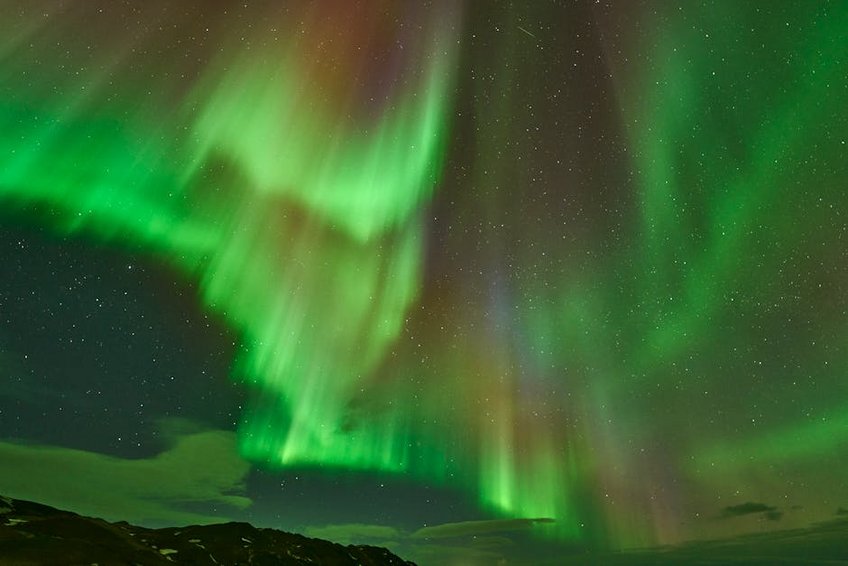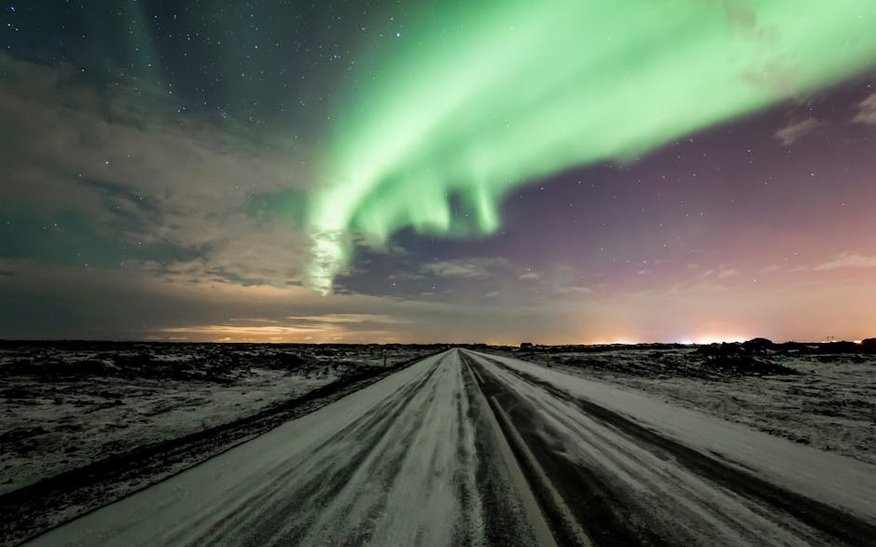Iceland Northern Lights – Your Complete Guide to the Aurora Borealis
Witnessing the Iceland Northern Lights, or Aurora Borealis, is a breathtaking natural phenomenon that tops many travel bucket lists. This spectacular light show occurs when charged particles from the sun collide with Earth’s atmosphere, creating dancing curtains of green, pink, and purple across the night sky. Iceland’s location near the Arctic Circle makes it one of the best places on Earth to experience this magical display, with optimal viewing conditions from September through April. The combination of dark winter nights, minimal light pollution, and Iceland’s dramatic landscapes creates an unforgettable backdrop for aurora hunting. Whether you’re a photographer seeking the perfect shot or simply want to experience one of nature’s greatest wonders, chasing the Northern Lights in Iceland promises an adventure you’ll remember forever. Planning your trip carefully will significantly increase your chances of success, from choosing the right time to visit to selecting the best viewing locations across this incredible island nation.
Iceland Northern Lights – Essential Information
Understanding the science and mechanics behind the Northern Lights will enhance your appreciation of this natural wonder and help you plan your Iceland adventure more effectively. The Aurora Borealis occurs when solar particles interact with Earth’s magnetic field, creating energy that manifests as colorful light displays typically between 60-75 miles above the Earth’s surface. The most common color is green, caused by oxygen molecules, while nitrogen produces blue or purple hues, and higher-altitude oxygen creates rare red auroras. Iceland’s position just below the Arctic Circle means you can see the lights throughout the country, though darkness, clear skies, and solar activity are all crucial factors. The KP index, measuring geomagnetic activity on a scale of 0-9, helps predict visibility – you’ll typically need a KP of 2-3 for good viewing in Iceland. Many excellent aurora forecast apps and websites provide real-time data to help you plan your nightly hunts during your Iceland Northern Lights adventure.
What Causes the Northern Lights – The Science Behind the Magic
- Solar winds carrying electrically charged particles travel toward Earth at speeds up to 3 million mph
- Earth’s magnetic field directs these particles toward the polar regions where they collide with atmospheric gases
- These collisions excite oxygen and nitrogen atoms, which then release photons of light as they return to normal state
- The altitude of collisions determines colors: green (60-150 miles), red (150-200 miles), blue/purple (up to 60 miles)
- Budget travel: $1,200-1,800 per person for 5 nights including flights, hostel accommodation, self-guided tours, and grocery meals
- Mid-range experience: $2,500-3,500 per person for 5 nights including flights, hotel accommodation, 2-3 guided tours, and restaurant meals
- Luxury adventure: $4,000-6,000+ per person for 5 nights including business class flights, premium hotels, private guided tours, and fine dining
- Icelandic Meteorological Office Aurora Forecast
- Inspired by Iceland Northern Lights Information
Best Viewing Conditions – What You Need for Success
Successful Northern Lights viewing requires specific conditions that you should monitor carefully during your Iceland trip. Darkness is essential – you’ll need complete nighttime between September and April, with the darkest months (December-January) offering the longest viewing windows. Clear skies are equally important, as cloud cover will completely obscure the aurora no matter how strong the solar activity. You’ll want to check both aurora forecasts and cloud cover predictions, which are readily available through Icelandic meteorological services. Solar activity, measured by the KP index, should ideally be at 2 or higher for good visibility. Finally, you need to escape light pollution – traveling away from cities like Reykjavik dramatically improves your chances. Many travelers combine these factors by taking guided tours whose experts monitor conditions and know the best spots for Iceland Northern Lights viewing each night.

Iceland Northern Lights – Planning Your Trip
Careful planning significantly increases your chances of successful Northern Lights viewing while making your Iceland adventure more enjoyable and stress-free. The aurora season runs from late August to mid-April, with peak visibility typically between September and March when nights are longest and darkest. You’ll want to allocate at least 5-7 nights specifically for aurora hunting to account for potential cloudy nights or low solar activity. Many travelers combine Northern Lights viewing with other winter activities like glacier hiking, ice cave exploring, or soaking in geothermal pools. Booking accommodations in advance is crucial, especially during peak seasons around Christmas and New Year’s. Consider your transportation options carefully – while self-driving offers flexibility, winter road conditions can be challenging for inexperienced drivers. Guided tours often provide the best combination of expert knowledge, safety, and increased viewing opportunities for your Iceland Northern Lights experience.
Best Time to Visit Iceland for Northern Lights
The optimal time for Iceland Northern Lights viewing balances darkness duration, weather conditions, and tourist crowds. September and October offer relatively mild weather with decent darkness hours and the advantage of fewer tourists compared to peak winter months. November through February provides the longest nights (up to 20 hours of darkness) but also the most challenging weather with frequent storms and precipitation. March and early April bring increasing daylight but often clearer skies and more stable weather patterns. Each period has advantages: winter months offer the darkest skies while spring months provide better weather conditions. Many experienced aurora chasers prefer the shoulder seasons of September-October and March-April for the combination of reasonable darkness hours and more predictable weather. Regardless of when you visit, plan for at least 5-7 nights to maximize your chances of clear skies and strong solar activity during your Iceland Northern Lights adventure.
Budget Planning and Costs for Northern Lights Trip
Essential Preparation Checklist
Proper preparation will ensure you’re comfortable and ready when the Northern Lights appear during your Iceland adventure. Pack thermal base layers, insulated waterproof outerwear, warm hats, gloves, and sturdy waterproof boots to withstand Iceland’s cold, often wet winter conditions. Bring hand and foot warmers for extended nighttime viewing sessions that might involve standing still for photography. Photography equipment is crucial – a DSLR or mirrorless camera with manual settings, a sturdy tripod, and extra batteries (which drain quickly in cold weather) will help you capture the aurora effectively. Download essential apps like Aurora Forecast, Vedur (Icelandic weather), and SafeTravel Iceland before arrival. Consider purchasing travel insurance that covers winter weather disruptions and potential tour cancellations. Finally, maintain flexibility in your itinerary – successful Iceland Northern Lights viewing often requires changing plans based on weather forecasts and aurora predictions.
Iceland Northern Lights – Top Viewing Locations and Activities
Iceland offers numerous spectacular locations for Northern Lights viewing, each with unique advantages and characteristics. The Golden Circle area, including Þingvellir National Park, provides relatively accessible viewing within easy reach of Reykjavik with minimal light pollution. The South Coast around Vik and Jökulsárlón glacier lagoon offers stunning backdrops of black sand beaches, glaciers, and icebergs illuminated by the aurora. The Snæfellsnes Peninsula in West Iceland provides dramatic coastal landscapes with the iconic Kirkjufell mountain as a foreground element. Remote areas like the Westfjords and Northeast Iceland offer exceptionally dark skies but require more travel time and preparation. Many visitors combine aurora viewing with other winter activities like glacier hikes, ice cave explorations, or soaking in geothermal pools during the day. Whether you choose self-driving or guided tours, selecting the right locations significantly enhances your Iceland Northern Lights experience.
Must-See Highlights for Aurora Viewing
Certain locations stand out as particularly spectacular for Iceland Northern Lights viewing due to their landscapes, accessibility, and minimal light pollution. Þingvellir National Park, just 45 minutes from Reykjavik, offers historical significance combined with dark skies and stunning geological formations. Jökulsárlón glacier lagoon on the South Coast provides an unforgettable backdrop of icebergs against the dancing aurora, with nearby Diamond Beach adding black sand and ice crystals to the composition. Kirkjufell mountain on the Snæfellsnes Peninsula has become iconic for photography, offering a perfect foreground element against the Northern Lights. The remote Westfjords provide exceptionally dark skies with dramatic fjord landscapes, though accessibility in winter can be challenging. For those staying near Reykjavik, the Grotta Island Lighthouse offers a convenient nearby option away from city lights. Each of these locations offers unique advantages for capturing and experiencing the magic of Iceland Northern Lights.
Hidden Gems and Local Favorites
Beyond the famous spots, Iceland contains numerous lesser-known locations that offer exceptional Northern Lights viewing without the crowds. The Þórsmörk valley, accessible only by specialized vehicles, provides a secluded mountain setting with incredible darkness levels. Landmannalaugar in the Highlands offers surreal rhyolite mountains as backdrops, though access is limited to summer except for special winter tours. The Djúpavík area in the remote Westfjords features abandoned herring factories and dramatic coastlines that create unique photographic opportunities. Local Icelanders often recommend the Reykjanes Peninsula, particularly around the Gunnuhver geothermal area, where steam vents add atmosphere to aurora photographs. The Eastfjords region around Seyðisfjörður offers picturesque fishing villages surrounded by mountains that frame the Northern Lights beautifully. Exploring these less-visited areas can provide more intimate and unique experiences of Iceland Northern Lights away from the main tourist routes.
Iceland Northern Lights – Practical Travel Information
Navigating Iceland during Northern Lights season requires understanding transportation options, accommodation choices, and essential safety considerations. Rental cars offer maximum flexibility for aurora chasing, but winter driving conditions demand experience with ice, snow, and potentially dangerous weather. Four-wheel drive vehicles are strongly recommended from October through April, and you should always check road conditions at road.is before traveling. Guided tours provide expertise and safety but less flexibility in your schedule. Accommodation ranges from Reykjavik hotels to countryside guesthouses and remote cabins – staying outside the city significantly improves your viewing opportunities. Booking well in advance is crucial, especially for popular dates around holidays. Safety is paramount: always dress appropriately for rapidly changing weather, never chase auroras in dangerous conditions, and inform someone of your travel plans when venturing into remote areas for Iceland Northern Lights viewing.
| Category | Options/Features | Price Range (USD) |
|---|---|---|
| Rental Car (4WD) | Includes winter tires, insurance, GPS | $80-150/day |
| Guided Tours | Small group, expert guides, hot drinks | $80-150/person |
| Accommodation (Reykjavik) | Hotels, guesthouses, apartments | $150-300/night |
| Accommodation (Countryside) | Farm stays, cabins, boutique hotels | $200-400/night |
| Photography Tours | Professional guidance, tripod included | $200-300/person |


